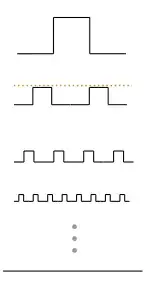Perimeter, surprisingly, isn't continuous.
What this means is that you can find shapes that are very similar to each other but which have different perimeters. You can also find a sequence of shapes that get more and more similar to a target shape, but don't get closer and closer in perimeter.
The reason is because you can take any shape and add an imperceptibly small amount of wiggle all around to the perimeter in order to change its perimeter without affecting its shape very much. The new object may make contact with the old object in many places, but because of the wiggles, their perimeters will not match. The way perimeter works, you do not need a large amount of wiggle in order to affect perimeter, just a large number of very small wiggles.
For example, consider the following sequence of line drawings. Each iteration, the number of "bumps" doubles, but their height is scaled by some amount (shown by the orange dotted line). In successive rounds, the shapes get closer and closer to the flat line shown at the bottom.

Their perimeter, however, is another story. Note that if you add up the horizontal line segments at any stage of this process, you get the full length of the flat line at the bottom. So there's a little extra length at each stage, which is contributed by the vertical components. That extra amount means a lot: depending on how the height is scaled, the objects' perimeter could approach any number at all.
- If the height is scaled in half each time, then the overall vertical components don't change, so the objects' perimeter stays the same at each stage— the number of bumps doubles, but their height is halved each time. This is exactly like the Manhattan distance example.
- If the height is scaled by a number larger than one half, then the perimeter will actually grow each iteration, because the doubling of the bumps outpaces the shrinking height.
- If the height is scaled by a number less than one half, then the perimeter will shrink each iteration. The vertical components will eventually vanish, so that in the limit ("at infinity") the two shapes will match in shape and in perimeter.
It's basically a strange fact about length that you can take a shape and add a lot of imperceptibly tiny wiggles along its perimeter to make an object that looks basically identical but has a radically, fractally different perimeter. In higher mathematics, this intuitive idea is formalized in various ways; for example, the way in which, in inverse problems, small amounts of noise can lead to arbitrarily large differences in the inferred model.
As for the staircase and Manhattan problems, both are examples of shapes that get closer and closer to some target shape whose length is known. In the case of the circle, the target length is known to be the circumference $\pi$. In the case of Manhattan distance, the target length is known to be the length of the hypotenuse, $\sqrt{x^2+y^2}$. Both examples use the perimeter trick to make a sequence of objects that get more and more similar to the target shape, but where the perimeters do something else entirely.
It doesn't matter how many times the curve touches the target shape because—essentially— wherever you're not touching the shape, you can wiggle and add however much extra perimeter you like. In fact, touching in more and more places gives an opportunity to add more and more (imperceptibly tiny, but crucial) deviations in between the places of contact.
